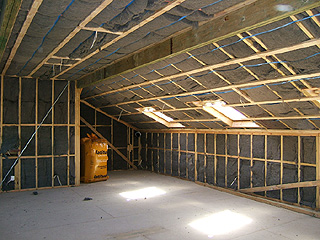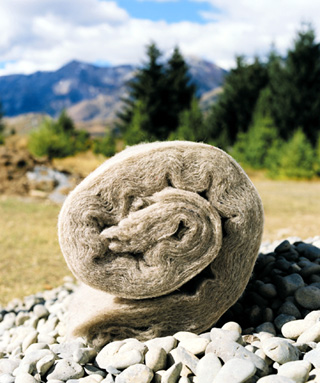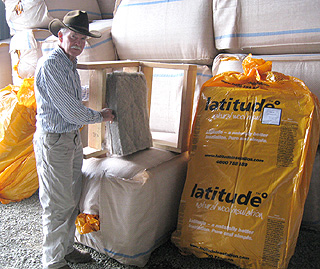|
Subscribe / Renew |
|
|
Contact Us |
|
| ► Subscribe to our Free Weekly Newsletter | |
| home | Welcome, sign in or click here to subscribe. | login |
Construction
| |

October 4, 2007
Is your house ready for a wool sweater?
Journal Staff Reporter
OREGON SHEEP rancher Joel Pynch says builders looking for effective insulation and LEED credits need only look to his herd.
Pynch's company, Oregon Shepherd, has partnered with a New Zealand business to sell wool building insulation in the Pacific Northwest. Pynch said he hopes it can heat up the area's cooling sheep industry, too.
Oregon Shepherd is working with New Zealand's Latitude, a company that has fitted 3,000 homes and buildings with the wool insulation since 1994. This is the company's first venture in the U.S., said Latitude Managing Director Graeme Marshall.
| What do you think? |
|
Click here to comment.
|
Marshall said American builders and homeowners are increasingly flocking to alternative sustainable building materials.
One of the key differences between wool and other insulations is its ability to actively adapt to moisture and air contaminants, Marshall said.
“The wool fiber has been designed by nature to keep the sheep warm and dry in cold and wet conditions and cool in hot dry summers,” Marshall said. “When sheep wool is used as insulation, it has been shown in laboratory scale experiments to keep the building cooler in summer and warmer in winter.”
It also absorbs the formaldehyde gas emitted from other building products, such as glues, Marshall said.
To make the insulation, cleaned and scoured wool is bonded with a nontoxic acrylic resin using a spray process for which Latitude holds a patent. The batt insulation holds its shape and is designed to friction-fit between framing or lay like a stiff blanket. Because it holds in place without glue or staples, areas can be insulated far faster than with typical fiberglass insulation, Pynch said. Latitude expands to fit walls, but when insulating floors it needs to be strapped, netted or stapled in.
There is one nick, Pynch admits: Latitude costs about three times as much as fiberglass. Oregon Shepherd is selling the product for $2.25 per square foot.
But Pynch said buyers aren't getting fleeced. The price is offset by reduced labor costs and the benefits of using a breathable and biodegradable product.
Latitude is also eligible for green-building credits. Ashley Katz, a spokeswoman with the U.S. Green Building Council, said using “rapidly renewable materials,” such as wool or cotton insulation helps projects earn LEED points. A project insulated with wool earns one LEED point, Katz said. Other alternative materials on the market include denim insulation made of recycled jeans, Katz said. That product was used to insulate a LEED gold rated office in Boulder, Colo., for an architectural firm.
Latitude uses coarse wool that is spun for rugs and carpets but often ends up in landfills, Pynch said.
Pynch, 73, owns Oregon Shepherd with his wife, Kay, and fellow Oregon sheep rancher Margaret Magruder. The Pynches have about 250 wool-producing ewes on their ranch just east of Astoria, and Magruder has another 250 on her ranch just north of Eugene. Pynch said they and fellow Oregon sheep ranchers have been seeking a market ever since the demand for coarse wool for rug yarn started dying out in the late-90s.
“At our place, we had accumulated five years of product,” Pynch said. “A number of sheep producers in the area, they were getting to a place where they were burying it and using it as weed control.”
There were about 50 million U.S. sheep at the end of World War II, the USDA says, compared to about 14 million today. In Oregon, that number has dropped from 2.3 million in 1920 to 215,000 today. And the price has been dropping as well. In 1994, wool brought in $1.04 a unit, compared to 68 cents a unit today.
Trying to find a new market, Oregon Shepherd started selling pet beds stuffed with the coarse wool. A few years ago, the company started pursuing wool insulation for homes, researching machinery to spray wool into attics for insulation. Then Pynch found out about the New Zealand-produced batts that could be used to insulate roofs, ceilings, walls and floors.
“We got together and decided let's share technologies and intellectual information,” Pynch said.
The company got its first buyer last weekend when a homeowner in Bend, Ore., bought 2,200 square feet of Latitude to insulate his home. Bruce Meland, who publishes a magazine on electric cars, is going to use Latitude to insulate a three-story addition he is building on the Norwegian pole-house he has been working on for 30 years.
Meland said he sought only green and renewable materials for the massive addition, including solar panels, a bronze roof and skylights.
“It is a progressive way to build, as the renewable materials such as Latitude insulation now are becoming available,” Meland said. “Not having to wear a breathing mask and getting fine glass particles in my eyes is more than worth it to me.”
Latitude is shipping the batts from New Zealand for now, but Pynch says as business picks up, he will use his wool as well.
“We will have a shortage of wool if it really goes like it seems like it's going to,” Pynch said. “Our hope is we will bring profitability back to wool for the sheep rancher.”
Shawna Gamache can be
reached by email or by phone
at (206) 622-8272.
Previous columns:
- Tight urban sites spawn creative excavations, 09-27-2007
- Where does that construction waste go?, 09-20-2007
- Engineers work to keep a floating bridge floating, 09-06-2007
- A high-tech solution for crane safety?, 08-30-2007
- School district tries to beat inflation by building three schools at once, 08-16-2007
- Construction pricing guide goes green, 08-09-2007
- Want to start your own apprentice program?, 08-02-2007
- Habitat for Humanity sees green in Olympia, 07-19-2007





